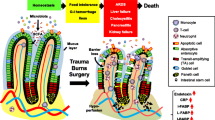Abstract
Inadequate microcirculation in sepsis and shock causes tissue injury. In this chapter the small intestinal circulation will be used as an example of such tissue injury. The selection of the small intestine as an example is made for two reasons: this organ represents those that early suffer from inadequate microcirculation in critical illness and, moreover, the consequences of gut tissue injury are thought to be of significant importance for the further development into multiple organ dysfunction.
Access this chapter
Tax calculation will be finalised at checkout
Purchases are for personal use only
Preview
Unable to display preview. Download preview PDF.
Similar content being viewed by others
References
Haglund U, Bulkley GB, Granger DN (1987) On the pathophysiology of intestinal ischemic injury. Acta Chir Scand 153:321–324
Kvietys PR, Granger DN (1982) Relation between intestinal blood flow and oxygen uptake. Am J Physiol 242:G202-G208
Bailey RW, Bulkey GB, Hamilton SR, Morris JB, Haglund U (1987) Protection of small intestine from nonocclusive mesenteric ischemic injury due to cardiogenic shock. Am J Surg 153:108–116
Falk A, Redfors S, Myrvold H, Haglund U (1985) Small intestinal mucosal lesions in feline septic shock: a study on the pathogenesis. Circ Shock 17:327–337
Haglund U (1993) Therapeutic potential of intraluminal oxygenation. Crit Care Med 21: S69-S71
Lundgren O, Haglund U (1978) The pathophysiology of the intestinal countercurrent exchanger. Life Sci 23:1411–1422
Haglund U, Jodal M, Lundgren O (1984) The small bowel in arterial hypotension and shock. In: Sheperd AP, Granger DN (eds) Physiology of intestinal circulation. Raven, New York, pp 305–319
Dahn MS, Lange P, Lobdell K, Hans B, Jacobs LA, Mitchell RA (1987) Splanchnic and total body consumption differences in septic and injured patients. Surgery 101:69–80
Arvidsson D, Rasmussen I, Almqvist P, Niklasson F, Haglund U (1991) Splanchnic oxygen consumption in septic and hemorrhagic shock. Surgery 109:190–197
Wollert S, Rasmussen I, Lundberg C, Gerdin B, Arvidsson D, Haglund U (1993) Inhibition of CD 18-dependent adherence of polymorphonuclear leukocytes does not affect liver oxygen consumption in fecal peritonitis in pigs. Circ Shock 41:230–238
Rasmussen I, Haglund U (1992) Early gut ischemia in experimental fecal peritonitis. Circ Shock 38:22–28
Antonsson JB, Haglund UH (in press) Gut intramucosal pH and intraluminal p02 in a porcine model of peritonitis or hemorrhage. Gut (in press)
Ljungdahl M, Rasmussen I, Haglund U (1995) Flow dependency of gastro-intestinal mucosal acidosis in sepsis (Abstrac). Shock 3 [Suppl 2]:22
Fink MP, Kaups KL, Wang H, Rothschild HR (1991) Maintenance of superior mesenteric arterial perfusion prevents increased intestinal mucosal permeability in endotoxic pigs. Surgery 110:154–161
Fink MP, Cohn SM, Lee PC, Rothschild HR, Deniz YF, Wang H, Fiddian-Green RG (1989) Effect of lipopolysaccharide on intestinal intramucosal hydrogen ion concentration in pigs: Evidence of gut ischemia in a normodynamic model of septic shock. Crit Care Med 17: 641–646
Granger DN, Rutili G, McCord JM (1981) Superoxide radicals in feline intestinal ischemia. Gastroenterology 81:22–29
Parks DA, Bulkley GB, Granger DN, Hamilton SR, McCord JM (1982) Ischemic injury in the cat small intestine: role of superoxide radicals. Gastroenterology 82:9–15
Editor information
Editors and Affiliations
Rights and permissions
Copyright information
© 1996 Springer-Verlag Italia, Milano
About this chapter
Cite this chapter
Haglund, U. (1996). Intestinal Microvascular Injury. In: Gullo, A. (eds) Anaesthesia, Pain, Intensive Care and Emergency Medicine — A.P.I.C.E.. Springer, Milano. https://doi.org/10.1007/978-88-470-2203-4_11
Download citation
DOI: https://doi.org/10.1007/978-88-470-2203-4_11
Publisher Name: Springer, Milano
Print ISBN: 978-3-540-75014-7
Online ISBN: 978-88-470-2203-4
eBook Packages: Springer Book Archive




